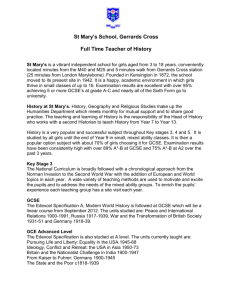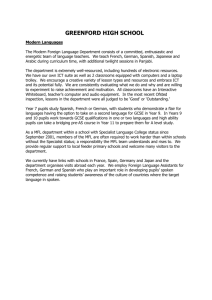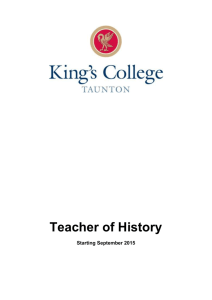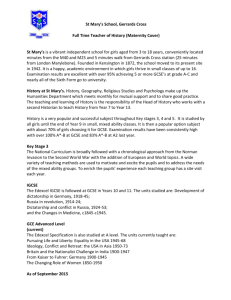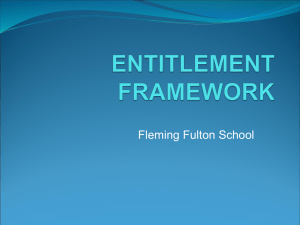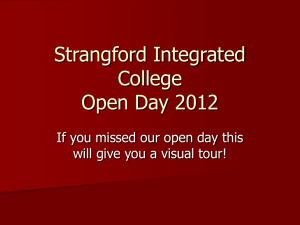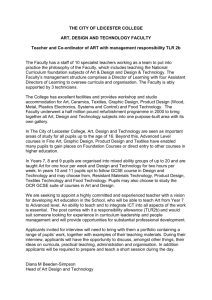OCR Nationals
advertisement
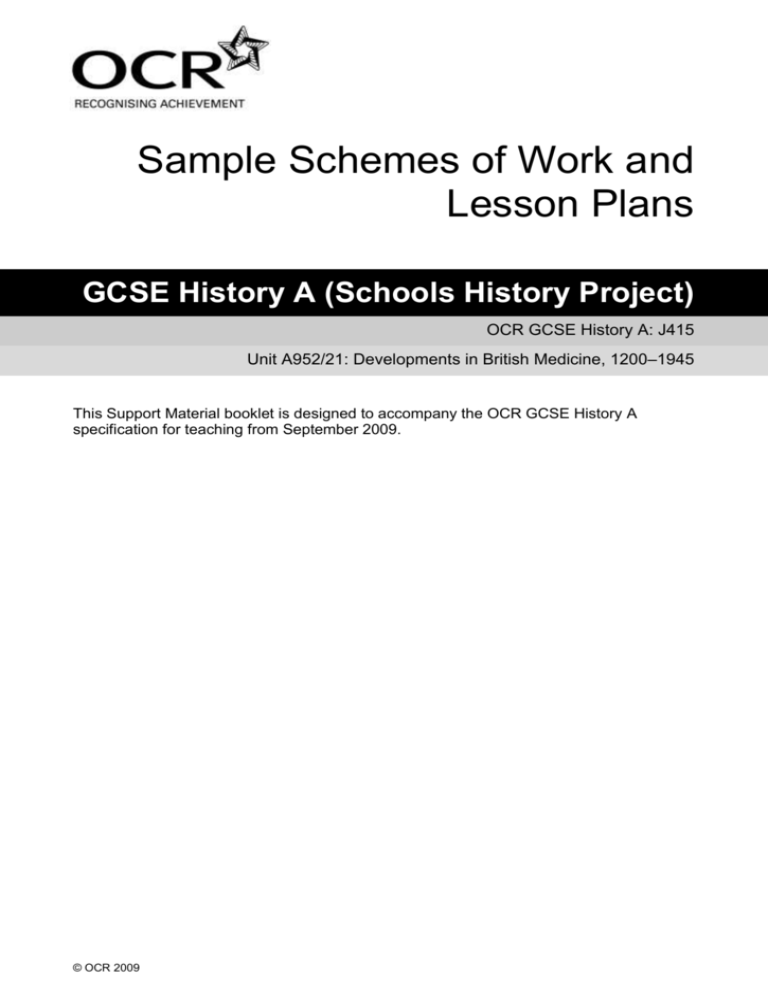
Sample Schemes of Work and Lesson Plans GCSE History A (Schools History Project) OCR GCSE History A: J415 Unit A952/21: Developments in British Medicine, 1200–1945 This Support Material booklet is designed to accompany the OCR GCSE History A specification for teaching from September 2009. © OCR 2009 Contents Contents 2 Introduction 3 Sample Scheme of Work: Unit A952/21: Developments in British Medicine, 1200– 1945 5 Sample Lesson Plan: Unit A952/21: Developments in British Medicine,1200–1945 11 2 of 12 GCSE History A (Schools History Project) Introduction Background Following a review of 14–19 education and the Secondary Curriculum Review, the Qualifications and Curriculum Authority (QCA) has revised the subject criteria for GCSEs for first teaching in September 2009. This applies to all awarding bodies. The new GCSEs have more up-to-date content and encourage the development of personal learning and thinking skills in your students. We have taken this opportunity to redevelop all our GCSEs to ensure they meet your requirements. These changes will give you greater control of assessment activities and make the assessment process more manageable for you and your students. Controlled assessment will be introduced for most subjects. OCR has produced a summary brochure, which summarises the changes to History. This can be found at www.ocr.org.uk along with the new specification. In order to help you plan effectively for the implementation of the new specification, we have produced these Schemes of Work and sample Lesson Plans for History. These Support Materials are designed for guidance only and play a secondary role to the Specification. Our Ethos OCR involves teachers in the development of new support materials to capture current teaching practices tailored to our new specifications. These support materials are designed to inspire teachers and facilitate different ideas and teaching practices. Each Scheme of Work and set of sample Lesson Plans is provided in Word format – so that you can use it as a foundation to build upon and amend the content to suit your teaching style and students’ needs. The Scheme of Work and sample Lesson Plans provide examples of how to teach this unit and the teaching hours are suggestions only. Some or all of them may be applicable to your teaching. The specification is the document on which assessment is based and specifies what content and skills need to be covered in delivering the course. At all times, therefore, this Support Material booklet should be read in conjunction with the specification. If clarification on a particular point is sought, then that clarification should be found in the specification itself. GCSE History A (Schools History Project) 3 of 12 A Guided Tour through the Scheme of Work = Innovative Teaching Idea This icon is used to highlight exceptionally innovative ideas. = ICT Opportunity This icon is used to illustrate when an activity could be taught using ICT facilities. 4 of 12 GCSE History A (Schools History Project) Sample GCSE Scheme of Work Unit A952/21: Developments in British Medicine, 1200–1945 Suggested teaching time 5 hours Topic outline Topic Historical Sources Investigation Suggested teaching and homework activities Suggested resources Points to note Teacher to provide students with a worksheet containing an historical source, student friendly copy of mark scheme for an interpretation question and a mock answer to Level 1 standard Two historical sources (subject to be determined by classroom teacher, but cartoons will work well with this exercise) OCR paper 2 mark scheme sources of conditions in Victorian London: http://www.victorianlondon.org/houses/slums.htm Students to mark answer then suggest how the answer could be improved, with reference to the pupil friendly mark scheme Also useful will be Medicine Investigations, C Shephard and R Rees, John Murray. There is guidance at the beginning on answering Paper 2 questions and source exercises (some on nineteenth- century public health). Interpreting sources Key question: What is the message of this source? Use the source to explain your answer. Students feedback to class at which point teacher can model construction of interpretation answers Teacher introduces a second source on a similar subject with students creating their own answer Students swap answers then peer assess each other’s work, adding targets for improvement from pupil friendly mark scheme = Innovative teaching idea GCSE History A (Schools History Project) Paper 2 mark scheme can be found by following link or alternatively going to OCR home page = ICT opportunity 5 of 12 Sample GCSE Scheme of Work Unit A952/21: Developments in British Medicine, 1200–1945 Suggested teaching time 5 hours Topic Historical Sources Investigation Topic outline Suggested teaching and homework activities Suggested resources Points to note Interpretation in context OCR paper 2 mark scheme Work of John Snow- John Snow society Students will need a basic knowledge of John Snow and his work in Broad Street Work of John Snow- BBC Teachers should familiarise themselves with mark scheme for this type of question found at OCR website How does Source A (A Court for King Cholera) help you understand the importance of the work of John Snow? Use the source and your own knowledge. = Innovative teaching idea 6 of 12 Students will be shown how to use an historical source and their own knowledge together to construct question answers 1. Pupils to arrange a list of statements into order regarding threats to public health in the nineteenth century. e.g. Lack of proper sewers allowed filth to get into drinking water 2. Give pupils Source A (A Court for King Cholera) for them to highlight all threats to public health 3. Pupils to annotate source with detailed inferences of each threat to public health Teacher to lead pupils through question highlighting what is the important part (importance of the work of John Snow) 4. Group work to mind map work of John Snow (recall task) and examine how his work in 1832 links to the Source A (A Court for King Cholera) The Development of Medicine for OCR GCSE, C Shephard, Hodder, page 125. The threats to public health are detailed here but need to be deleted when the cartoon is first given to students. = ICT opportunity GCSE History A (Schools History Project) Sample GCSE Scheme of Work Unit A952/21: Developments in British Medicine, 1200–1945 Suggested teaching time 5 hours Topic outline Topic Historical Sources Investigation Suggested teaching and homework activities Suggested resources Points to note OCR Paper 2 mark scheme Source C. A Cholera Warning poster. Warrington Board of Health. www.1museumstreet.co.uk/wdia/house_health/02 a.htm&h=247&w=350&sz=43&hl=en&start=1&usg =__DveuMqRqcSdg4NDNMHxdtmnNu8g=&tbnid =4UVvmU62vU58JM:&tbnh=85&tbnw=120&prev= /images%3Fq%3D1832%2Bcholera%2Bwarringto n%26gbv%3D2%26hl%3Den Pupils will need a knowledge of Edwin Chadwick and the social reform process of the 19th century Teachers should familiarise themselves with mark scheme for this type of question found at OCR website source in question 5. Class discussion on how the source is related to the work of John Snow 6. Pupils to attempt key question Usefulness of sources Students will develop their ability to evaluate the usefulness of historical sources Key question: Teacher to lead introduction to issue of usefulness of sources by explaining it is not the same as reliability and that the usefulness of sources depends on what you want to find out Pupils to conduct usefulness investigation into a range of sources - what would they be useful as evidence of, what they would not be useful as evidence of? Pupils must state what is useful/ not useful for each source to foster idea every source has something positive to offer and should not be discarded Pupils complete a table with useful/ not How useful is this source as evidence about the work of Edwin Chadwick in the 19th century? Use the source and your knowledge to explain your answer. = Innovative teaching idea GCSE History A (Schools History Project) = ICT opportunity 7 of 12 Sample GCSE Scheme of Work Unit A952/21: Developments in British Medicine, 1200–1945 Suggested teaching time 5 hours Topic outline Topic Historical Sources Investigation Suggested teaching and homework activities Suggested resources Points to note Pupils will need a basic understanding of the lack of public health measures in Britain in the early part of the 19th century (before any reforms) Teachers should familiarise themselves with mark scheme for this type of question found at OCR website useful columns to asses the usefulness of the source Source Comparison Key question: Do you think source C is more useful than Source D in enquiring into Public Health in early 19th century Britain? = Innovative teaching idea 8 of 12 Pupils to attempt key question Pupils will practise all techniques developed so far, interpretation, inference and source usefulness and further develop the ability to compare sources as pieces of historical evidence 1. Groups to complete individual useful/ not useful tables examining content of Source C then feed back to class 2. Individual pupils complete above task for Source D individually 3. Teacher- led modelling of how to show/ highlight the similarities and differences between historical sources by drawing a simple table to record the similarities and differences between the two OCR Paper 2 mark scheme Source D. Painting of 19th Century Westminster. Westminster Slum. G.B Roy www.medphoto.wellcome.ac.uk = ICT opportunity GCSE History A (Schools History Project) Sample GCSE Scheme of Work Unit A952/21: Developments in British Medicine, 1200–1945 Suggested teaching time 5 hours Topic outline Topic Historical Sources Investigation Suggested teaching and homework activities Suggested resources Points to note Pupils will need an overview of public health problems and solutions of the 19th century. Teachers should familiarise themselves with mark scheme for this type of question found at OCR website sources. This process must be done simultaneously Interpretation Key question: Edwin Chadwick was of huge importance in changing Public Health in Britain. How far do the sources on this paper support this view? Explain your answer. 4. Pupils to complete above process 5. Pupils to attempt key questions Students will reach a conclusion about an historical interpretation using a collection of sources and their own knowledge 1. Groups read collection of sources and record which sources agree with and disagree with the interpretation. Groups to be reminded to select quotes to justify their assertions 2. Teacher to model a Level 3 response, reminding pupils of the need to use their own knowledge to support what the source is saying. “Source B shows Chadwick highlighting the awful condition people lived in the towns with evidence. This shows what a big problem there was and spurred Remember to identify the sources you use = Innovative teaching idea GCSE History A (Schools History Project) OCR Paper 2 mark scheme Source B. The sanitary conditions of the labouring population Sparticus Schoolnet www.sparticus.schoolnet.co.uk/PHchadwick.htm = ICT opportunity 9 of 12 Sample GCSE Scheme of Work Unit A952/21: Developments in British Medicine, 1200–1945 Suggested teaching time 5 hours Topic outline Topic Historical Sources Investigation Suggested teaching and homework activities Suggested resources Points to note others to solve the problems” = Innovative teaching idea 10 of 12 3. Teacher to inform class that to gain a Level 4 they must use the sources and their own knowledge and the sources to both agree and disagree with the interpretation 4. Pupils to attempt similar task but disagreeing with the interpretation using a different source 5. Pupils to conclude answer giving their own opinion on the interpretation using the sources and their knowledge = ICT opportunity GCSE History A (Schools History Project) Sample GCSE Lesson Plan Unit A952/21: Developments in British Medicine,1200–1945 Comprehension and inference OCR recognises that the teaching of this qualification will vary greatly from school to school and from teacher to teacher. With that in mind, this lesson plan is offered as a possible approach but will be subject to modification by the individual teacher. Lesson length is assumed to be one hour. Learning Objectives for the Lesson Objective 1 To select evidence to use in an interpretation question Objective 2 To make simple inferences based on source material Objective 3 To make complex inferences about medicine from an historical source Recap of Previous Experience and Prior Knowledge First Key Stage Four lesson on using historical sources. A basic knowledge of medicine through time will be needed. As this is a generic source skills lesson, the lesson plan can be adapted to any topic Content Time Content 10 minutes Hand out cards to selected pupils with emotions on them happy sad etc. Pupils to act out these emotions whilst rest of class tries to guess the emotion. Teacher to explain how they have just worked with a source and determined its meaning. 15 minutes Teacher to give students: An historical source (subject to be determined by teacher and can be either picture/ text etc Student- friendly copy of mark scheme for interpretation questions Mock answer to Level 1 standard. Pupils attempt to mark answer Reflect how it could be improved 10 minutes Class as a group mark answer underlining where answer hits Level 1 Class discuss how the answer could be improved (with reference to mark scheme) AFL GCSE History A (Schools History Project) 11 of 12 Sample GCSE Lesson Plan 15 minutes Teacher introduces second source with interpretation question. Pupils to place source subject in historical context and refresh their knowledge on the subject Pupils to attempt question Consolidation Time Content 10 minutes Pupils to explain in their own words what an inference is. For more able explain how an inference becomes a complex inference 12 of 12 GCSE History A (Schools History Project)

